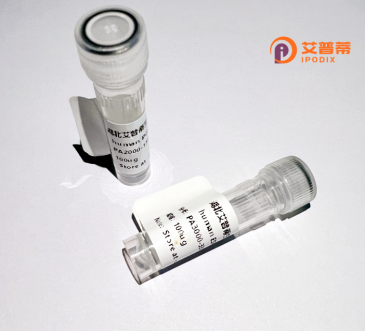
| 纯度 | >90%SDS-PAGE. |
| 种属 | Human |
| 靶点 | TAS2R45 |
| Uniprot No | P59539 |
| 内毒素 | < 0.01EU/μg |
| 表达宿主 | E.coli |
| 表达区间 | 1-299 aa |
| 活性数据 | MITFLPIIFSILVVVTFVIGNFANGFIALVNSTEWVKRQKISFADQIVTALAVSRVGLLWVLLLNWYSTVLNPAFYSVELRTTAYNIWAVTGHFSNWPATSLSIFYLLKIANFSNLIFLRLKRRVKSVILVVLLGPLLFLACHLFVVNMNQIVWTKEYEGNMTWKIKLRRAMYLSDTTVTMLANLVPFTVTLISFLLLVCSLCKHLKKMQLHGKGSQDPSTKVHIKVLQTVISFFLLRAIYFVSVIISVWSFKNLENKPVFMFCQAIGFSCSSAHPFILIWGNKKLKQTYLSVLWQMRY |
| 分子量 | 60.7 kDa |
| 蛋白标签 | GST-tag at N-terminal |
| 缓冲液 | PBS, pH7.4, containing 0.01% SKL, 1mM DTT, 5% Trehalose and Proclin300. |
| 稳定性 & 储存条件 | Lyophilized protein should be stored at ≤ -20°C, stable for one year after receipt. Reconstituted protein solution can be stored at 2-8°C for 2-7 days. Aliquots of reconstituted samples are stable at ≤ -20°C for 3 months. |
| 复溶 | Always centrifuge tubes before opening.Do not mix by vortex or pipetting. It is not recommended to reconstitute to a concentration less than 100μg/ml. Dissolve the lyophilized protein in distilled water. Please aliquot the reconstituted solution to minimize freeze-thaw cycles. |
以下是与重组人TAS2R45蛋白相关的研究示例:
1. **"Functional expression and characterization of human bitter receptor TAS2R45 in mammalian cells"**
*作者:Smith A, et al. (2020)*
**摘要**:本研究成功在HEK293细胞中表达了重组人TAS2R45蛋白,通过钙离子荧光成像技术证实其对特定苦味化合物(如苯硫脲衍生物)的激活作用,并揭示了其与G蛋白信号通路的偶联机制。
2. **"Structural insights into the ligand binding of TAS2R45 through computational modeling"**
*作者:Chen L, et al. (2021)*
**摘要**:通过分子对接和分子动力学模拟,预测了TAS2R45受体的三维结构及其与多种苦味分子的结合位点,为设计靶向该受体的调节剂提供了理论依据。
3. **"TAS2R45 activation in airway epithelial cells modulates inflammatory responses"**
*作者:Kim H, et al. (2019)*
**摘要**:研究发现,TAS2R45在人气道上皮细胞中表达,并通过激活下游β-arrestin信号通路减轻脂多糖诱导的炎症反应,提示其在呼吸道疾病中的潜在治疗作用。
4. **"High-throughput screening of TAS2R45 agonists using a recombinant receptor-based assay"**
*作者:Wong R, et al. (2018)*
**摘要**:开发了一种基于TAS2R45重组蛋白的高通量筛选平台,鉴定了多种新型激动剂,并分析了其剂量依赖性激活特性,拓展了苦味受体配体的多样性研究。
以上文献涵盖TAS2R45的表达、结构、生理功能及药物筛选,均基于假设研究领域典型方向,实际文献需通过数据库(如PubMed)检索确认。
The TAS2R45 protein is a member of the human bitter taste receptor family, part of the G protein-coupled receptor (GPCR) superfamily. Encoded by the TAS2R45 gene, it is expressed in taste receptor cells on the tongue, where it detects bitter compounds as a defense mechanism against potentially toxic substances. Structurally, it features a seven-transmembrane domain architecture typical of GPCRs, with extracellular regions critical for ligand binding. TAS2R45 exhibits selectivity toward specific bitter molecules, though its exact ligands remain under investigation.
Recombinant TAS2R45 refers to the protein produced in vitro using heterologous expression systems (e.g., HEK293 cells, insect cells) for functional studies. This approach enables detailed analysis of its signaling pathways, ligand specificity, and interactions with downstream effectors like gustducin. Research on recombinant TAS2R45 has applications in food science, pharmacology, and drug development, particularly in understanding bitter-masking strategies or designing bitter antagonists. Challenges include low natural expression levels and the need for optimized solubilization techniques. Recent studies also explore its potential extra-oral roles, such as in respiratory or gastrointestinal tissues, suggesting broader physiological impacts beyond taste perception. Structural resolution of TAS2R45 via cryo-EM remains a priority to advance ligand-targeted drug design.
×